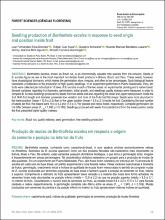Por favor, use este identificador para citar o enlazar este ítem:
https://hdl.handle.net/20.500.12921/410Registro completo de metadatos
| Campo DC | Valor | Lengua/Idioma |
|---|---|---|
| dc.contributor.author | Dionisio, Luiz Fernandes Silva | - |
| dc.contributor.author | Cusi Auca, Edgar | - |
| dc.contributor.author | Schwartz, Gustavo | - |
| dc.contributor.author | Bardales Lozano, Ricardo | - |
| dc.contributor.author | Miró Agurto, Jimmy | - |
| dc.contributor.author | Corvera Gomringer, Ronald | - |
| dc.date.accessioned | 2019-11-19T17:28:52Z | - |
| dc.date.available | 2019-11-19T17:28:52Z | - |
| dc.date.issued | 2019-07 | - |
| dc.identifier.citation | Revista Brasileira de Ciências Agrárias, 14(3): e5662 Dionisio, L. F. S., Auca, E. C., Schwartz, G., Bardales-Lozano, R. M., Agurto, J. J. M., & Corvera-Gomringer, R. (2019). Seedling production of Bertholletia excelsa in response to seed origin and position inside fruit. Revista Brasileira de Ciências Agrárias, 14(3), 1-9. | es_ES |
| dc.identifier.issn | 1981-0997 | - |
| dc.identifier.uri | https://hdl.handle.net/20.500.12921/410 | - |
| dc.identifier.uri | http://dx.doi.org/10.5039/agraria.v14i3a5662 | - |
| dc.description.abstract | Bertholletia excelsa, known as Brazil nut, is an economically valuable tree species from the Amazon. Seeds of B. excelsa figure as one of the most important non-timber forest products in Bolivia, Brazil, and Peru. These seeds, however, have physiological dormancy, which makes the germination slow, irregular, and often in low percentages. Such biological feature represents a bottleneck to the production of high quality seedlings. In an experiment performed in Puerto Maldonado, Peru, ten fruits were collected per individual in 15 trees of B. excelsa in each of the two areas: an experimental planting and a native forest. Several variables regarding fruit biometry, germination, initial growth, and seedlings quality indexes were measured in order to compare B. excelsa seedlings produced by seeds from two areas and also regarding the lower and upper seed position inside the fruit. Both fruit length and diameter presented low variation and most of the fruits had flat shape. Seeds were more abundant in the lower position (mean = 12.9 ± 2.2) than in the upper position (mean = 6.5 ± 2.1) inside the fruit. Considering the total number of seeds per fruit, the means were 19.4 ± 3.2 and 17.5 ± 3.7 for planted and native forest, respectively. Complete germination did not differ between areas (F1, 56 = 1.945, p = 0.169). Seedlings produced with seeds from planted and from the lower position inside the fruit presented higher quality indexes. | es_ES |
| dc.format | application/pdf | es_ES |
| dc.language.iso | eng | es_ES |
| dc.publisher | Universidade Federal Rural de Pernambuco | es_ES |
| dc.relation | info:eu-repo/semantics/article | es_ES |
| dc.relation.uri | http://www.agraria.pro.br/ojs-2.4.6/index.php?journal=agraria&page=article&op=view&path%5B%5D=agraria_v14i3a5662 | es_ES |
| dc.rights | info:eu-repo/semantics/openAccess | es_ES |
| dc.rights.uri | http://creativecommons.org/licenses/by-nc-nd/2.5/pe/ | es_ES |
| dc.source | Instituto Investigaciones de la Amazonía Peruana | es_ES |
| dc.source | Repositorio Institucional - IIAP | es_ES |
| dc.subject | Bertholletia Excelsa | es_ES |
| dc.subject | Germinación de las semillas | es_ES |
| dc.subject | Semillas | es_ES |
| dc.subject | Características de semillas | es_ES |
| dc.subject | Poder germinativo | es_ES |
| dc.subject | Germinabilidad de las semillas | es_ES |
| dc.subject | Plántulas | es_ES |
| dc.subject | Amazonía | es_ES |
| dc.subject | Madre de Dios | es_ES |
| dc.title | Seedling production of Bertholletia excelsa in response to seed origin and position inside fruit | es_ES |
| dc.type | info:eu-repo/semantics/article | es_ES |
| dc.identifier.journal | Revista Brasileira de Ciências Agrárias | es_ES |
| dc.description.peer-review | Revisión por pares | es_ES |
| dc.identifier.doi | http://dx.doi.org/10.5039/agraria.v14i3a5662 | es_ES |
| Aparece en las colecciones: | Artículos en revistas indexadas | |
Ficheros en este ítem:
| Fichero | Descripción | Tamaño | Formato | |
|---|---|---|---|---|
| Dionisio_articulo_2019.pdf | Texto Completo | 1,64 MB | Adobe PDF |  Visualizar/Abrir |
Compartir :
Este ítem está sujeto a una licencia Creative Commons Licencia Creative Commons




